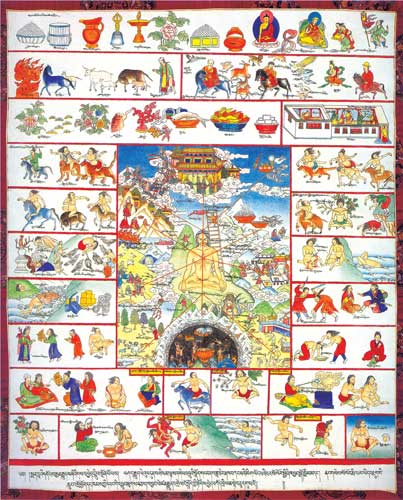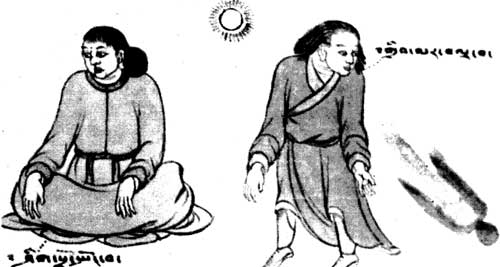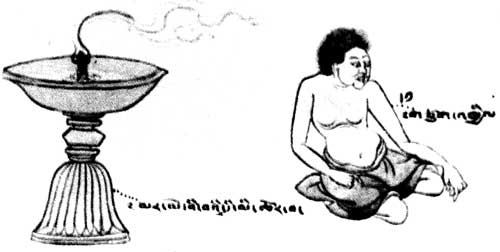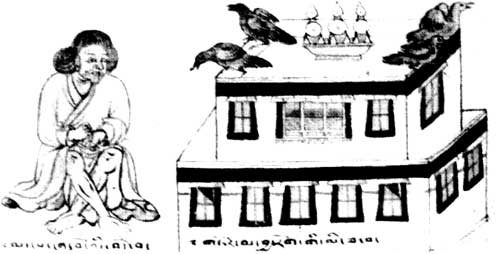
Thangka;Death Omens(1) Photo by Dempa Dekyi
At each and every moment the things of our universe are subject to change. The human body too, from the very moment it is born, begins the process that will ultimately lead to death.
At birth, a connection between the body and the external world is established that will continue throughout life. The birth year of the person determines (for all people born in that year) the general quality of his or her life-energy, body, capacity, fortune and of the Lha.
Specific factors such as the month, day, hour, planets and constellations, and in addition the physical constitution of father and mother, prefigure the physical and psychological distinguishing features of each person.
Once these connections are established, the continuous interaction taking place between the person and the external world will determine the amelioration or deterioration of the person's physical condition, and the person's feeling of well-being or suffering linked to psychological condition.
The origin of the signs that indicate physical decay

One of the death omens is that louses suddenly disappear and the shadow of a man is distorted (selected from Four Medical Classics).
Physical decay is announced by signs or omens indicative of death. The presence of fire can be deduced by smoke and the presence of a pond by herons; likewise, dreams, auspicious or inauspicious, and changes of mood may foretell the encounter with favorable or unfavorable influences.
Such influences, which arise from the interaction of the person and the external world, and are felt throughout the day and even in each moment of our life, are part of the natural dynamic. Nonetheless, the harm or benefit that they may bring is reversible. The Conclusive Treatise of Medicine states:
The body of any creature is formed from the four elements,
The ailments themselves, which are to be cured, are caused by the four elements,
The remedies, or medicines themselves, are of the nature of the four elements.
Thus, body, illness and the remedy are linked by an identical nature, and Patient and doctor meet because karmically connected.
Accordingly, when external influences attack the persons' health, they can be averted by taking recourse to a remedy whose properties are able to counteract this aggression. Through the horoscope (of the persons' entire life) or through other means, undesirable situations that may occur in a particular year can be foretold. When such undesirable situations manifest or are announced by premonitory dreams, these can be prevented and averted by changes in one's life habits. For example, one can go to live in a different place, change the shape and color of one's bed, or wear clothes of colors different from those one usually wears. These methods utilize the properties of the four elements, expressed through forms and colors. If the properties of forms and colors interrelate positively, in accordance with the criteria of the "four cycles: mother and son, friend and enemy"1 with the general characteristics of the individual (life energy, body, capacity etc.) They will influence the person favorably, otherwise they will have a negative influence.

Being smelly with unkept hair is one of the death omens for men
Customarily, in Tibet, to encourage the recovery of a person from an illness, rituals of got, del mdos, and yas e2 and rituals to the are performed. To symbolize the five elements, ritual objects such as silk or woolen scarves of different colors, ritual objects such as the namka3, or the three-dimensional namka (built with threads of various colors), and multicolored arrows, and tops are used. Other methods include laying lime on the floor of the house and the kitchen, piling votive images in the vicinity of one's house and raising prayer flags. These rituals and methods are intended to avert the harm a negative combination of the elements might bring. In ancient times, these rituals were performed on the basis of knowledge of the energy of the elements. In our time, we can perhaps find a scientific explanation for these rites. Nonetheless they may seem to be sheer superstition when performed by people ignorant of the underlying principles.
Examining the distant indications predicting death
In Tibetan medical treatises, the distant indications predicting death are examined taking into consideration (a) indications concerning the messenger from the patient, (b) indications that are revealed in dreams, and (c) the mood of the patient.

One of death omens is that people see a naked man or ghost(selected from Four Medical Classics)
Examining the messenger from the patient
This is a system used by the doctor to investigate the auspicious or inauspicious circumstances associated with the arrival of the messenger from the patient in the doctor's presence or those that occur at the time or on the road as the doctor visits the house of the patient.
1) A messenger is unfavorable when he or she is a villain, malicious, has an inauspicious name, wears unorthodox clothes or ornaments or speaks insultingly.
The moment is inauspicious when the messenger finds the doctor angry, swearing rudely, chopping or destroying some material objects, making offerings to the on behalf of deceased ancestors, or performing a burnt offering ritual4.
Unfortunate times for the doctor to set out for the patient's house include the fourth, the sixth and the ninth days of the lunar month5, the days of a solar or lunar eclipse, days on which there is a negative combination of the elements of the day, of the week, and the elements of the corresponding constellation (as in the so-called "deadly combination" between the fire and the water element), and when it is getting dark.
Unfortunate omens encountered by the doctor on the road to the patient's house include: the breaking of objects the doctor carries, seeing something being burnt or broken, hearing someone weeping, assisting in a murder, having the road crossed by a cat, a monkey, an otter or a snake.

A death indication comes to a man if he dreams he is Laying down on the sky burial platform, circled by vultures and hungry ghosts(selected from Four Medical Classics)
2) A messenger is auspicious for the recovery of the patient when remarkable, i.e., educated, dedicated to virtue, of noble aspect, and whose garb and language conform to the best customs of the country.
The types of fortunate omen encountered on the road by the doctor that foretell the recovery of the patient, are described in The Exegetical Treatise in the following ways:
It is auspicious to see a jar full of cereals or curd,
A ritual bell, a burning butter lamp, flowers, rice,
Roasted barley, cooked barley dough balls,
An image of a deity, white ornaments,
Someone performing religious practices,
Someone raising a victory standard,
A burning fire, a newly-born foal, lamb, calf
Or another animal with the mother,
To hear melodious singing, to see delicious foods and
Drinks or, gracious ornaments.
The interpretation of the signs that enable the doctor to understand whether the patient will recover or die is related the culture and history of each country. It is difficult to attribute to it universal and scientific validity. Some signs viewed as favourable in a certain society are unfavorable for another. It should be understood that the aforementioned description taken from The Exegetical Treatise fits and is linked to Tibetan customs...
Premonitory signs are not groundless because sometimes animals are more sensitive than human beings. Some domestic animals (yaks, dogs, mice, etc...) can tell if there is an earthquake coming or birds can indicate if it is going to rain.. Why not pay more attention to them?
Animals can sense the internal and external signs of the elements. There is more meaning in their behavior than we think.
